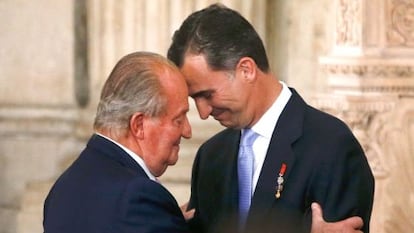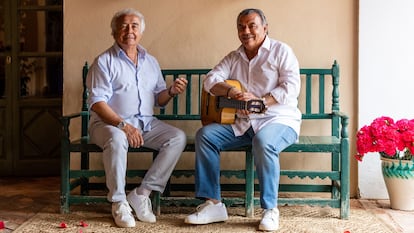The year in review: Our most-read feature articles of 2021, part 1
The coronavirus crisis and the volcanic eruption on La Palma dominated the news headlines over the past 12 months, but readers of the EL PAÍS English Edition had a wealth of other topics to discover. Check out numbers 11 to 20 on our list

Thanks to the ongoing coronavirus pandemic, another extraordinary year of news is drawing to a close. Just like in 2020, the EL PAÍS newsroom has been working flat out to inform the public of all the latest developments from the health crisis, and the English Edition has been toiling just as hard to bring all of that news to its readers too.
It’s no surprise, then, to see that numerous news stories about Covid-19 are among our most-read articles of the year, accompanied, of course, by coverage of the spectacular eruption of a new volcano on the Canary Island of La Palma.
But away from current affairs, the English Edition has brought its readers a regular diet of feature articles too, on subjects ranging from Basque genetics and the Spanish royal family, to topics such as the future of artificial intelligence and the “perpetual crisis” in Argentina.
This is part one of our curated list of most-read feature articles of the year, with part two to come on New Years Eve.
Thanks to you all for reading, and let’s hope for everyone’s sake that there is a little bit less news in 2022...
20. Spain’s King Felipe VI struggles to repair tarnished image of royal family
The Spanish Royal Family has had a torrid time these last years, and that’s largely unrelated to the pandemic. Court cases and accusations of financial wrongdoing continue to swirl around the reputation of emeritus king Juan Carlos, who opted last year to leave Spain and live in the United Arab Emirates. In this article, EL PAÍS reporter Miguel González examines the efforts of King Felipe VI to repair the image of the Spanish royal family, asking whether the monarch can fix the damage.
19. Coronavirus: How infected air can flow from one apartment to another
In Spain, the bathrooms of older buildings are connected through communal ducts that allow aerosol exchanges. Although not common, it is suspected that transmission can occur in specific circumstances from building to building. This feature, created in conjunction with the multi-award-winning Infographics team at EL PAÍS, examines just how that can happen.
18. The making of ‘Macarena,’ the Spanish smash hit that got the world dancing
In 1996, the whole world got swept up in Macarena madness. The original flamenco hit composed by the Seville duo known as Los del Río – made up of Antonio Romero and Rafael Ruiz – had already rocketed up the charts in Spain in 1993. But the Bayside Boys’ dance remix, which incorporated female vocals in English, stayed at the top of the Billboard Hot 100 for 14 weeks that summer and remained on the charts for 66 weeks. Twenty-five years later, the duo looks back on the highs and lows of their runaway success in this interview with Sergio del Amo.

17. When playing video games becomes a full-time job
The coronavirus pandemic has led to the transformation of many sectors and video games is one of them. Jorge A. García explores games such as Axie Infinity, CrytpoKitiies and The Sandbox, which have created a new digital market that has transformed entertainment into cash.
16. Argentina’s perpetual crisis
A hundred years ago Argentina was one of the richest countries in the world. Since then, it has suffered average annual inflation of 105% and has had to change currency five times. In this feature article, Spanish journalist and writer Enric González asks, where does the curse of the Argentine economy stem from?
15. How an 11th-century buried treasure ended up for sale on social media
Political instability and fear prevailed in the Caliphate of Córdoba in the 11th-century, after a civil war broke out over power in the territory – comprising Al-Andalus, the Muslim-ruled area of the Iberian peninsula, and parts of North Africa. This, according to experts, could explain why a rich Jewish citizen buried a spectacular collection of treasure in what is today the municipality of Baena, Córdoba in Spain’s southern Andalusia region. EL PAÍS archeology and heritage expert Vicente G. Olaya explains how, a thousand years later, a photograph that appeared on social media alerted the National Police in the region to the treasure’s existence and the fact that it could be illegally traded.

14. Defenders of bilingual education in Spain: ‘It’s a mistake to think that students will speak English like they do Spanish’
The issue of bilingual education in Spain’s schools is a hot topic, with defenders and critics alike. In this feature article, EL PAÍS education reporter Ana Torres speaks to language experts and teachers in primary and secondary schools, to discover the pros and cons of a system that many feel has failed to provide the desired skills.
13. Artificial intelligence uncovers the building blocks of life and paves the way for a new era in science
Science stories have been among our most popular this year at the English Edition, and this piece from Manuel Ansede, science reporter from the EL PAÍS Materia section, was no exception. In it, he explains how British neuroscientist Demis Hassabis founded a company called DeepMind, which set itself the task of solving one of the greatest challenges in biology.
12. Why the shutters are coming down on many of Spain’s Chinese bazaars
The brutal blow to consumption triggered by the coronavirus pandemic has had a huge impact on Asian traders running Chinese bazaars in the biggest Spanish cities. This article examines how many of these large stores ended up either empty or were in the process of shutting up shop as their owners return to China in significant numbers.
11. Calatrava la Vieja: the ancient Spanish city of the four hidden treasures.
Another story from Vicente G. Olaya, who on this occasion explains how archeologists have pieced together part of the history of finds made around the walls of a town in Spain’s Ciudad Real province, and which was a frontier fortress during the medieval wars between Muslims and Christians.
Part two of our Most Read Features of 2021 will be published on December 31.
Tu suscripción se está usando en otro dispositivo
¿Quieres añadir otro usuario a tu suscripción?
Si continúas leyendo en este dispositivo, no se podrá leer en el otro.
FlechaTu suscripción se está usando en otro dispositivo y solo puedes acceder a EL PAÍS desde un dispositivo a la vez.
Si quieres compartir tu cuenta, cambia tu suscripción a la modalidad Premium, así podrás añadir otro usuario. Cada uno accederá con su propia cuenta de email, lo que os permitirá personalizar vuestra experiencia en EL PAÍS.
¿Tienes una suscripción de empresa? Accede aquí para contratar más cuentas.
En el caso de no saber quién está usando tu cuenta, te recomendamos cambiar tu contraseña aquí.
Si decides continuar compartiendo tu cuenta, este mensaje se mostrará en tu dispositivo y en el de la otra persona que está usando tu cuenta de forma indefinida, afectando a tu experiencia de lectura. Puedes consultar aquí los términos y condiciones de la suscripción digital.
Últimas noticias
Not all insomnia is the same: Study identifies five subtypes and paves the way for personalized treatment
The United States designates Clan de Golfo as a foreign terrorist group
The United States strikes three more suspected drug boats, killing eight
The Iberian Peninsula is rotating clockwise, scientists report
Most viewed
- ‘El Limones’ and the growing union disguise of Mexican organized crime
- Christian Louboutin: ‘Young people don’t want to be like their parents. And if their parents wear sneakers, they’re going to look for something else’
- ‘We are dying’: Cuba sinks into a health crisis amid medicine shortages and misdiagnosis
- A mountaineer, accused of manslaughter for the death of his partner during a climb: He silenced his phone and refused a helicopter rescue
- The low-cost creative revolution: How technology is making art accessible to everyone









































